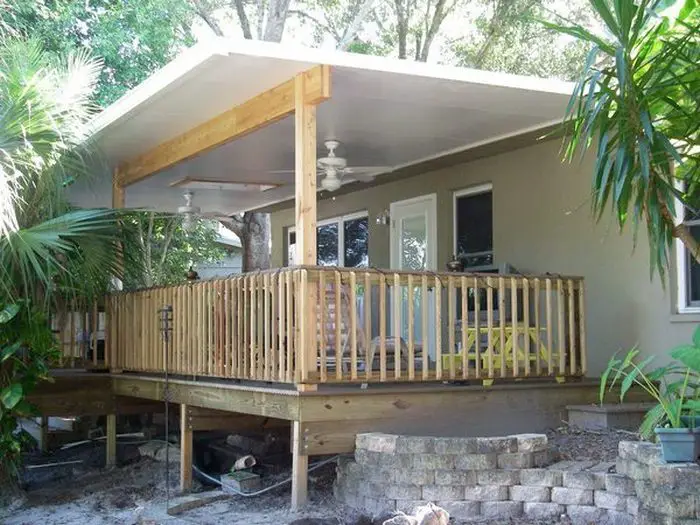Last time we talked about deck flooring and balustrades. With the flooring and balustrades in place your deck is ready to use. But one vital question remains – to roof or not to roof?
Installing a roof isn’t just about protecting your deck from the climate. In fact, as long as you’ve properly weatherproofed your deck you can rest assured that it’s safe from nearly anything the weather can throw at it. A roof allows you to enjoy your deck at any time, rain, hail or shine. A roof can also minimise maintenance if you’ve built near trees – you won’t have to worry about sweeping up the leaves every time you want to use it.
Roofing installation
Sturdy deck roofing can withstand the test of time, saving you from the unnecessary expense and hassle of repairs.
Choosing the right roof pitch
Deck roofing comes in different shapes and sizes, but regardless of the design, the roofing’s ability to effectively drain water depends upon its pitch – the degree of slope..
Flat deck roofing – called skillion – is easy to install and economical to boot, as you only require a limited number of steel sheets for a full build. It’s also convenient when it comes to maintenance as it supports weight well.
The downside of flat deck roofing is that if the pitch is inadequate rain water will pool leading to potential leakage problems. Water pooling on top of the roof can also create a haven for mosquitoes – the last thing you need if you are out enjoying your new deck!
Read and take note of roof manufacturer specifications. While some metal roofs need only a one degree slope (1 centimetre per metre) other profiles need a minimum five degrees (5 centimetres per metre). Examples would be a ‘Cliplock’ profile needing only one degree while corrugated profiles must have a minimum of five degrees. The reality is that any slope can channel water towards the gutters and down spouts helping to eliminate any problems that may come with leakage or standing water. From personal experience, I choose a minimum 2.5 degree pitch for any profile where 1 degree is specified as adequate and definitely 5 degrees or more for corrugated profiles.
Overhangs
Make sure you have enough roof overhang so that water does not run back under the roofing on to your deck – especially if you have minimum pitch.
Aesthetics
Obviously, you want your deck roof to blend with the house. However, be aware that pitched roofs, whether they are gable or hip, will be more expensive than a skillion roof. Both gable and hip are more labour intensive and also require more materials. A hip roof is the most complex and expensive option.
Insulation
Unless you have a minimum 2.7 metres (9 foot) of clearance under your roof, I strongly recommend you insulate. If you want to understand how much heat can radiate through a roof in peak summer, take a trip into your home’s roof space!
If you decide to insulate, consider one of the bonded roofing options. These are a ‘sandwich’ of roofing and insulation with a finished underside. The material cost is higher but some of these sheets can span six metres (20 feet) reducing framing and finishing costs. The bonus is that they look very ‘finished’ once they are up.
Curtains
If you have decided to roof your deck, you should also consider adding clear vinyl roll-up curtains. In fine weather keep them rolled up out of the way so that you can enjoy the breeze and the view. But when it rains, or in cold weather, they can transform your deck into a year round, weather independent living space.
Summary:
Roofing your deck will multiply its usability by offering excellent weather protection, especially with side curtains. The roof will also enhance the visual appeal of the deck which, in turn, should increase the value of your home to any intending purchaser.
In our next post we’ll discuss whether to oil or stain your deck…
In the meantime. if you have any questions or suggestions – or simply a comment – just type it below and I’ll respond.






